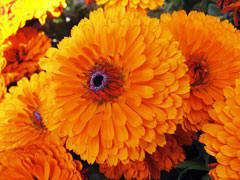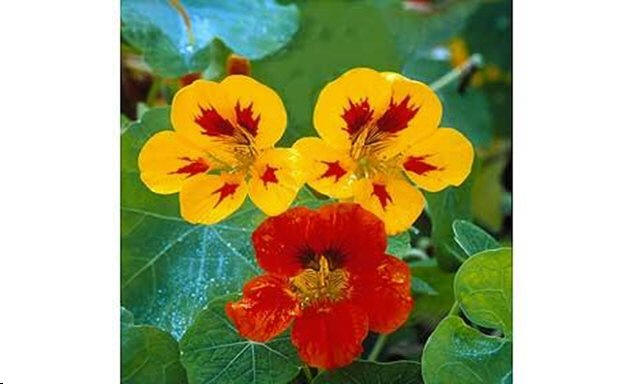![]()
Edible Flower Uses - Culinary and Medicinal
Calendula

Culinary Uses:
Fresh petals are chopped and added to salads. The dried petals have a more concentrated flavour and are used as a seasoning in soups, cakes etc. High in vitamins A and C. An edible yellow dye is obtained from the petals. A saffron substitute, it is used to colour and flavour rice, soups etc.
Medicinal Uses:
One of the best known and versatile herbs in Western herbal medicine and is also a popular domestic remedy. It is, above all, a remedy for skin problems and is applied externally to bites and stings, sprains, wounds, sore eyes, varicose veins etc. It is also a cleansing and detoxifying herb and is taken internally in treating fevers and chronic infections. Only the common deep-orange flowered variety is considered to be of medicinal value. The flowers are antiphlogistic, antiseptic, antispasmodic, aperient, astringent, cholagogue, diaphoretic, emmenagogue, skin, stimulant and vulnerary. The flowers are used fresh or dried, for drying they are harvested when fully open and need to be dried quickly in the shade. A tea of the petals tones up the circulation and, taken regularly, can ease varicose veins. An application of the crushed stems to corns and warts will soon render them easily removable. It is used internally in order to speed the healing of wounds. The German Commission E Monographs, a therapeutic guide to herbal medicine, approve Calendula officinalis for inflammation of the mouth and pharynx (throat), wounds and burns.
References:
http://www.pfaf.org/user/Plant.aspx?LatinName=Calendula+officinalis
Nasturtium

Culinary Uses:
Nasturtium has been used in the kitchen for centuries. All parts of this flower are edible and each have a unique taste and texture. Overall, the plant has a bittersweet peppery flavor. The pickled seeds are often described as tasting like roasted capers. Oil is often extracted and used in cooking foods to give them a spicy mustard-like taste.
Medicinal Uses:
Topical Treatment
Leaves or petals can be ground up using a mortar and pestle to make an ointment. This paste can be used in multiple ways because it has antibiotic, antiseptic, and antifungal properties. The ointment can be used to treat minor cuts and scrapes as well as help treat some types of acne and skin irritations.
Internal Treatment
Leaves and petals are often seeped in hot water to make a tea. This tea has many versatile uses. It alleviates respiratory infections, prevents scurvy, urinary tract diseases, regulates hyperthyrodism and stimulate the digestive tract. The flower is also a great source of vitamin C.
References:
http://bioweb.uwlax.edu/bio203/s2012/stipan_sama/nutrition.htm
https://www.garden.org/ediblelandscaping/?page=august_edible